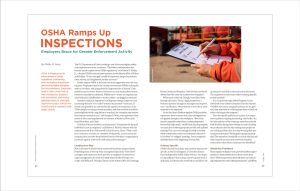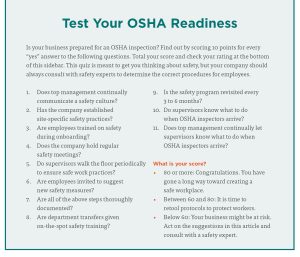OSHA Ramps Up Inspections
Employers Brace for Greater Enforcement Activity
OSHA is stepping up its enforcement of safety regulations, performing more workplace inspections and levying higher penalties for noncompliance. Employers need to take a fresh look at their workplaces, establish safe procedures, and ensure adequate levels of oversight. Supervisors play a critical role in reinforcing a company-wide safety culture.
The U.S. Department of Labor is taking a new look at workplace safety, and employers are in the crosshairs. “The Biden administration has become much tougher about OSHA regulations,” said Edwin G. Foulke, Jr., a former OSHA head and now a partner in the Atlanta office of Fisher and Phillips. “It has enlarged its staff of inspectors, ramped up enforcement activity, and heightened penalty amounts.”
Foulke expects OSHA to become even more aggressive over the coming year. “Employers need to be on their toes because OSHA’s looking for ways to cite them, and citing them for large amounts of money.” Cash penalties can be severe. Serious violations can run $15,625 (the amount increases annually for inflation). Willful ones—where an employer has acted with plain indifference to worker safety—are pegged at $156,259.
Another trend puts employers in still greater danger. Inspectors are increasing their use of so-called “instance by instance” violations, in which cash penalties are assessed by the number of violations in a set. “If five people are using a certain machine, and that machine is cited for noncompliance with a regulation or standard, the company may receive five citations instead of one,” said Douglas E. Witte, who represents businesses in labor and employment law matters at Madison, Wisconsin-based Boardman and Clark.
Costliest of all are accidents to third parties. “Sometimes the harmed individual is not an employee,” said Robert S. Nichols, Partner with the employment law firm of Bracewell LLP in Houston, Texas. “They could be a contractor, a vendor, or a member of the public. In such cases, the company does not have the protective barrier of workers’ compensation insurance against a lawsuit for full and punitive damages.”
Leading the Way
Now is the time to double down on protective policies and procedures. Everything starts at the top of the management pyramid. “If mid-level managers and supervisors don’t perceive an emphasis on safety from upper management, it’s much less likely they will take the topic seriously,” said William K. Principe, Partner in the Atlanta office of Constangy, Brooks, Smith and Prophete. “And it’s their combined efforts that will create an accident-free workplace.”
What starts at the top, though, must filter down through the ranks. “From a legal perspective, a business operates through its managers and supervisors,” said Nichols. “What they do or don’t do is often imputed to the employer.”
As the first line of defense against OSHA penalties, supervisors have to ensure that rules and regulations are applied throughout the workplace. “New hires must be properly trained from a safety perspective before they begin work,” said Nichols. Existing employees must also receive appropriate periodic and updated training. That can occur through monthly or weekly safety orientations, which are sometimes referred to as “toolbox” or “tailgate” meetings. Some companies schedule these at the beginning of every shift.
Getting Specific
OSHA will look for policies and practices that are site specific, noted Gary Heppner, a Cherokee, Kansas-based independent OSHA Safety Advisor. “An inspector typically goes into a shop, removes guards from a drill press, and then picks somebody at random to set up the press and drill an obscure hole in the metal. The employee’s actions must reflect training specific to that machine.”
It is not good enough, added Heppner, to just download some safety boilerplate from the Internet. “If OSHA sees that a company’s policies are too general, they may well do a fishing expedition to find out what is lacking in the program.”
Once the specific policies are in place, it is important to perform ongoing monitoring, said Foulke. “As the eyes and ears of the company, supervisors should walk the floor during the workday, not only checking the production line but also making sure people are not violating safety rules. Are they wearing their personal protective gear? Working the equipment properly? The supervisor should fill out a form that records what inspections were done and what remedial actions were taken when violations were identified.”
Obtaining Feedback
These regular workplace tours provide excellent opportunities to obtain feedback from those on the front lines. “Where supervisors often fall short is in not having employees be active safety participants,” said Witte. “Instead of just telling them how to operate a machine, establish two-way communications. Do they have additional safety concerns beyond what has been discussed? Sometimes a machine may not be working exactly as designed, and that can have safety ramifications.”
Temporary transfers of employees from one department to another often lead to safety violations and accidents. “Suppose there is a labor shortage in the warehouse and there’s an urgent need to get product onto trucks quickly,” said Heppner. “A call is made to another department that sends one or two workers to help. If these new arrivals do not receive the requisite safety training before they start work, any resulting injury can result in a citation.”
An effective safety program is not a one-and-done affair. As time passes, procedures get modified and new standards are required. “Every 3 to 6 months, it’s wise to go through your program to make sure it is still current,” said Heppner. “Any new safety issues must be addressed.”
Take special care when a new machine is added. Unfamiliar controls can lead to accidents. “Sometimes equipment vendors will send representatives to provide onsite training,” said Witte. “If employees are not present, managers and supervisors need to be there so they can pass on knowledge about how the machinery can be operated safely.”
Dealing with OSHA
An accident happens. Will the company be fined?
The answer depends to a great extent on how well the company has trained the involved employee, and how thoroughly documentation of that training has been maintained. But the employer may also be protected if the employee did not follow mandated safe work practices.
“When a citation is withdrawn by OSHA, it’s usually because the employer was able to establish a so-called ‘employee misconduct defense,’” said Foulke. For this defense to prevail, the employer must be able to provide a positive answer to each of the following four questions:
- Did the company establish safety rules that would have obviated the accident? “The foundation for any safety program is a set of rules that employees must follow,” said Principe. “These can include the use of personal protective equipment as well as safe standard operating procedures.”
- Were the safety rules communicated to the employee? “Supervisors must ensure all of the rules are communicated, from initial onboarding of the employee to continuing on-the-job training,” said Principe.
- Did the company monitor compliance with the safety rules? “OSHA expects you to ensure your employees are following the rules,” said Principe. This is where documented periodic workplace inspections by supervisors can make a difference.
- Were the rules enforced through progressive discipline? “Many companies make the mistake of only enforcing rules when there is an accident,” said Principe. “Continual enforcement is necessary, combined with progressive discipline.” An initial infraction might result in a verbal reminder of the safety rules. Repeated offenses might result in more severe penalties, up to and including dismissal.
Supervisors should create written records of all the above steps. Such documentation can be of immense help during an OSHA inspection that may result from an accident. It will provide the company representative with the information required to answer the questions from inspectors.
Because dealing with an OSHA inspection can be intimidating, Heppner recommends the use of a three-ring binder that contains the company’s safety protocols for each section of the workplace. This document will serve as powerful evidence that the company is conscientious about maintaining a safe environment. “Just slide the binder across the table to the OSHA inspectors,” said Heppner. “It will answer most of their questions.” The notebook can serve double duty as a blueprint for staff training during the year and a quick refresher course prior to OSHA’s arrival.
Being Proactive
With the threat of a recession on the horizon, and an ongoing battle with inflation, it is natural for managers to devote their energies to the challenges of marketing, production, and fulfillment. It is little wonder that the time and expense required to establish and maintain an effective safety program can appear to be an unwelcome pressure on the bottom line. “There’s no question that there’s a cost for safety, but there’s also a cost for noncompliance,” said Witte. “Those costs can include time off from work, injuries, and even deaths.”
It pays, then, to be proactive. “Having worked on a wide variety of OSHA fatality cases, I know that one of the biggest mistakes supervisors make is to think that employees are responsible for themselves, and if they make mistakes, it’s at their own risk,” said Nichols. “That’s not true. It is the supervisor’s obligation to look out for them and to correct noncompliance. And it’s the employer’s obligation to establish policies that keep workers safe from harm.”
Phillip M. Perry is an award-winning freelance writer based in New York City. His byline has appeared over 3,000 times in the nation’s business press. He can be reached at linkedin.com/in/phillipmperry.


